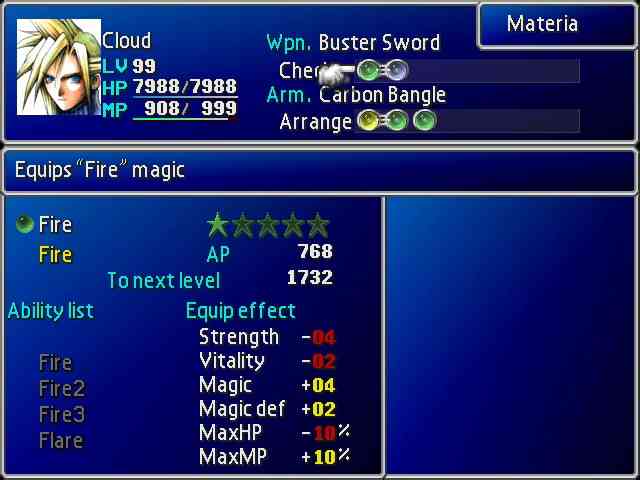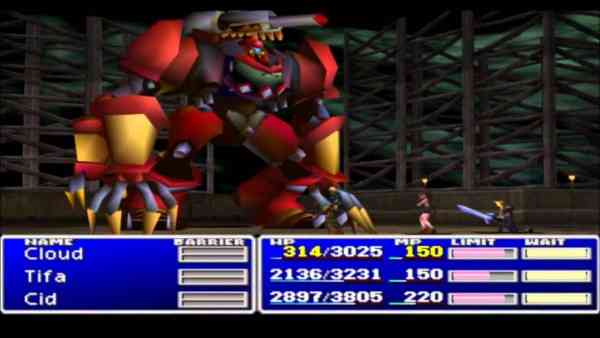Abilities, like spells you can cast, are gained by equipping Materia (this is where the fun comes in). Materia is the crystalized lifeforce of the planet. It can be equipped to your weapons and accessories. Different weapons and accessories can carry different amounts of Materia. Materia can grant the wearer spells (lightning attack), stat boosts (HP up 10%), and abilities (attack 2 times instead of 1). Some Materia can also reduce stats, so you have to pay attention to what you have equipped. Materia can also level up. For example, once Lightning gets to level 2, you can cast Lighting twice in the same battle. Max it out, and get a new Lightning Materia starting at level 1. There is also a spell called Lightning 2, which does more damage than Lightning, and also levels up.
There are two other details I have to mention about Materia. There are five types (colors) of Materia, and if you max out the levels of every single Materia of one color, you get a Master Materia that allows one character to equip every Materia of that type (while only taking up one weapon slot), cast them an unlimited amount of times (restricted only by how many magic points you have), and causes no stat reduction. Of course this takes a lot of wise equipping and level grinding to accomplish, but it’s very possible, and very satisfying.
The other detail I have to mention about Materia, is that one of the types is the Summon Materia. Summon Materia are very visually awesome attack spells, that cost lots of magic and take a toll on your stats, but do heavy damage to your opponents. The awesome looking demon from the commercials is the Ifrit summon. Giant demon comes out of the ground, spews fire out of its mouth, then flies at your enemies, and messes them up. Awesome.
Another awesome battle mechanic is limit breaks. After getting attacked enough, characters reach their limits, and gain the ability to do an extra powerful, fancy-looking attack. Each character has different stories, and stats, but the difference of who you choose to use in battle, will likely largely depend on their limit breaks. Limit breaks could be as simple as Cloud jumping in the air, and slamming his giant sword onto opponents, as complicated as Tifa’s slot machine/ timing based limit break, or as weird as Vincent’s demon transformation berserker limit breaks. All have their pros and cons, and you’ll be levelling them up, and trying out all the characters, if you want to experience them all (which is totally worth doing).
I made a note for myself to talk about the pros and cons of gameplay in this game, but there really aren’t any cons. This is the JRPG perfected. If you don’t like RPGs, you probably won’t like this game. Although there are many who say they don’t play RPGs, but they did play through Final Fantasy VII. If you really love modern PC-style/ western-style RPGs (ex. Skyrim, Mass Effect, Diablo, The Witcher, etc.), this game might not be good for you. Combat is not real time, and customization is not full-tilt Dungeons & Dragons-style.
The characters in Final Fantasy VII are all very unique, fleshed out, and well-written. They all have very specific powers and abilities, or powers and abilities that can be interchanged without penalty. And even though Cloud is a silent protagonist, he is very much his own character, and not so much a vehicle for the game player to enter the world.
______________________________
“I made a note for myself to talk about the pros and cons of gameplay in this game, but there really aren’t any cons. This is the JRPG perfected.”
Even if you’re a lover of modern JRPGs, Final Fantasy VII might seem simplistic in some of its combat systems now. There are two gameplay elements I could see as being issues today. The first is that battles happen randomly, which is a mechanic that RPG developers spent years trying to get rid of (and eventually did). The other is that you walk painfully slowly when traversing the pre-rendered backgrounds that make up the game’s areas. I found this quite jarring even in 1998, but I quickly got used to it, and recognized that it gave a sense of enormity to the areas I was exploring. But if the modern gamer is doing any backtracking, I could find the combination of these elements to be very frustrating.
In 1997, this game was innovating a bit, and perfecting a lot. Now, these mechanics are genre staples, and might seem primitive to modern gamers. I don’t think people will find this to be the case very often though; the gameplay and the combat flow so well.
Click on thru to page 3 for the continuing review.

